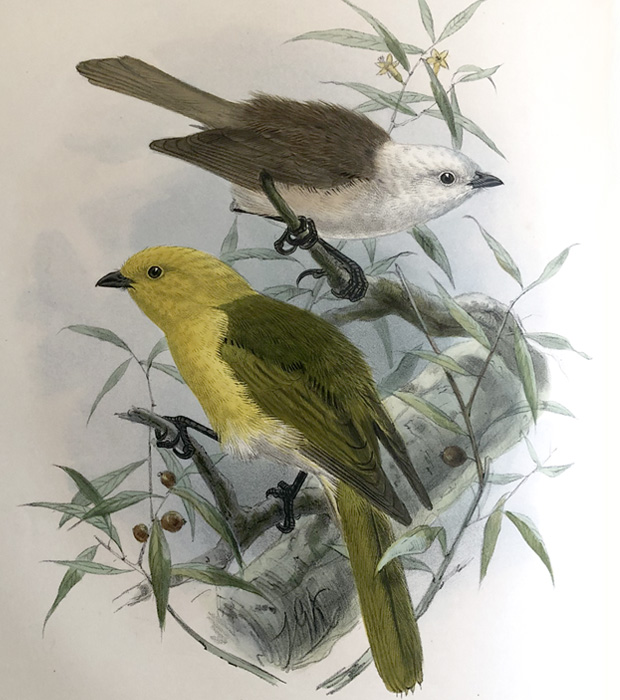


Mohua, the yellowhead, from John Gould's Birds of Australia, 1840–48.
"Mohua ochrocephala has been well named the bush canary. Its commonest call is a trill or rapid shivering rattle not unlike the pea whistle note of the popular cage bird. That is the ordinary means of communication in normal life. There is the sparrow-like chirp, a scolding note, a muffled, beseeching, supplicating utterance not often heard, and during incubation a whisper inaudible out of the nest hole. At dawn the rattling trilling chorus begins, becomes more silent towards noon and then again breaks forth, the little performers mostly unseen in the tee top greenery. When detected in full song near at hand, the very tail will be seen to vibrate with energy of the vocal outpouring, a passion of melody which is nevertheless prosaically, almost comically blocked in full jet by desire to scratch and search for vermin, a trouble peculiarly incident to the breed.
"Its plumage is well described in the name; the cock bird particularly is a handsome fellow, the yellows between his great black beady eyes and immediately above his dark brown bill sometimes shading almost into orange. The plumage of the female is faintlier marked. The tail shafts of the old birds are often abraded and worn, the legs are black. Gripping hard with the feet, legs spread, the strong horny bill is vigorously dug into the close fibred south and east facing moss clumps, that in the rain-forests beloved of the bush canary, glue themselves onto trunks and branches. Like the Pukeko and Kaka, the claw is utilised for holding morsels of food.
"When moving in flock at mid-bush levels, canaries are not infrequently accompanied by parakeets.
"Whatever may have been their practice in former periods, bush canary now (1936) chiefly haunt the high nothofagus forests of the interior. Their breeding season is in accordance with climatic conditions, that is relatively late, November and December. The species appears to be strictly insectivorous. Of the nests discovered nearly all were in dead timber, two in sound green-leafed living trees. The species elected was always beech. The clutch consists of two eggs; about twenty-one days is the duration of incubation.
"It is the dupe of the long–tailed cuckoo which means that many of its young are destroyed."


Mohua, the yellowhead, whitehead and the brown creeper from Walter Lawry Buller's Birds of New Zealand, 1888.
| Taxonomy | |
|---|---|
| Kingdom: | Animalia |
| Phylum: | Chordata |
| Class: | Aves |
| Order: | Passeriformes. |
| Family: | Pachycephalidae. |
| Genera: | Mohua. |
| Species: | ochrocephala. |
| Sub Species: |
Bush canary, Muscicapa chloris, Orthonyx ochrocephala, yellow headed flycatcher.
Endemic bird
15 cm., male 30 g., female 25 g., male has bright yellow head and underparts with black bill, eye and legs, upperparts yellow brown. Female and immature similar to male but crown and nape shaded brown.
South Island only, increasingly rare, Fiordland.
Mohua, the yellowhead
DOC Mohua page
Song of: — Mohua, the yellowhead
Viking Sevenseas
Gould, John, Birds of Australia, 1840–48.
Buller, Walter Lawry, Birds of New Zealand, 1888.
Heather, B., & Robertson, H., Field Guide to the Birds of New Zealand, 2000.
Oliver, W.R.B. New Zealand Birds, 1955.
Guthrie-Smith, H., Sorrows and Joys of a New Zealand Naturalist, 1936.
Friday, 8 September, 2023; ver2023v1